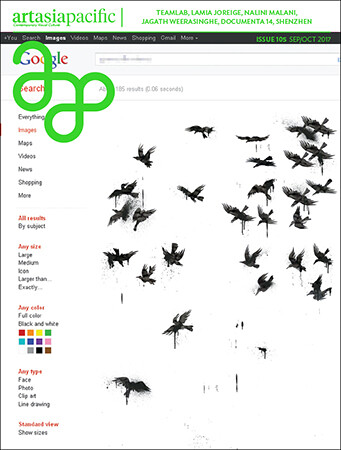ArtAsiaPacific
September/October 2017
Out now
www.artasiapacific.com
Far-flung parts of the world are becoming superficially similar, homogenized by commerce and tourism, yet their micro-histories remain full of fascinating details and rich stories. ArtAsiaPacific’s September/October issue looks at artists who examine stories of their respective environs. Some of the artists featured touch upon how their communities respond to seismic events, while others dream up futuristic virtual worlds.
For our cover Feature, AAP reviews editor Brady Ng delves into the high-tech wizardry of Japan’s teamLab. The around-400-member collective—comprising artists, technical professionals and designers—has dazzled audiences with immersive installations, which utilize cutting-edge technology and are often inspired by nature and premodern Japanese art, positing that life, and nature, will continue as it has before, or, at least, in digital form.
Capturing viewers in similarly vivid ways, but using analog techniques, is Mumbai-based artist Nalini Malani, revered for her experimental artworks, including video-shadow plays, that often explore the cultural legacies of a partitioned India. Before her major retrospective at Centre Pompidou in Paris in October and Castello di Rivoli Museo d’Arte Contemporanea in March, Daniel Kurjaković, curator of programs at Kunstmuseum Basel, sat down with Malani to discuss some of the lesser-known influences on her works, including the slum community near her former Bandra studio that was leveled by the city government.
Lebanese interdisciplinary artist Lamia Joreige also explores why places are the way they are. AAP editor-at-large HG Masters leads us through Joreige’s many artistic explorations of her home city Beirut, from her ongoing video project Objects of War, initiated in 1999, in which she records acquaintances speaking about objects that were important to them during the country’s wars (1975–90), to her more recent 2013 book Objects Missing from the National Museum of Beirut.
Looking at a difficult national history through the lens of trauma and the positive implications of artistic practice in scrutinizing these events, AAP contributing editor Jyoti Dhar introduces the work of Sri Lanka’s Jagath Weerasinghe. For more than 25 years, the artist, teacher and archaeologist has actively responded to the country’s decades of civil conflict through his expressive figure paintings, performances and installations.
In our special column, Inside Burger Collection, Bharti Lalwani discusses ideas of home and inclusion within South-Asian-American immigrant creative communities.
This issue’s Profiles look at four enterprising, energetic artists. We hear about the virtual adventures of MIT Media Lab artist Sputniko!, known for her idiosyncratic projects such as the wearable Menstruation Machine – Takashi’s Take (2010); New York-based Iranian abstract painter Ali Banisadr, whose canvases convey myriad references, including the 1978–79 Islamic Revolution; London-based Faiza Butt, who taps into Pakistani artistic traditions to question gender and sexuality; and Australian artist Robert Andrew, whose kinetic machines explore his Indigenous heritage.
Elsewhere in the issue, Joe Zhu files a Dispatch from Shenzhen—now buzzing with artistic camaraderie and new exhibition spaces, developed seemingly overnight. In One on One, Cambodian artist Khvay Samnang explains his admiration for Zhang Huan’s use of his body to narrate social politics. Reviews include Yayoi Kusama’s extensive survey, Life is the Heart of a Rainbow, at the National Gallery Singapore, Subodh Gupta’s engaging In This Vessel Lies the Philosopher’s Stone at Galleria Continua in San Gimignano, and more. In The Point, Stephen Cheng of Hong Kong’s Empty Gallery, an unconventional space that embraces experimental art forms, asks future art patrons to “support what only you can, what only you will, what only you see, and don’t be afraid to let the beauty and the chaos in. Art should by nature make a mess.”
Subscribe to the print edition or buy digital copies on iTunes, Google Play, Zinio or Magzter. Subscribers can access our entire back-issue catalog in ArtAsiaPacific’s Digital Library. Download the ArtAsiaPacific City Guide app today to be in the know about events and openings in 53 countries and territories across Asia, the Pacific and the Middle East!


